instrument panel FORD E SERIES 2014 4.G Owners Manual
[x] Cancel search | Manufacturer: FORD, Model Year: 2014, Model line: E SERIES, Model: FORD E SERIES 2014 4.GPages: 438, PDF Size: 5.12 MB
Page 6 of 438
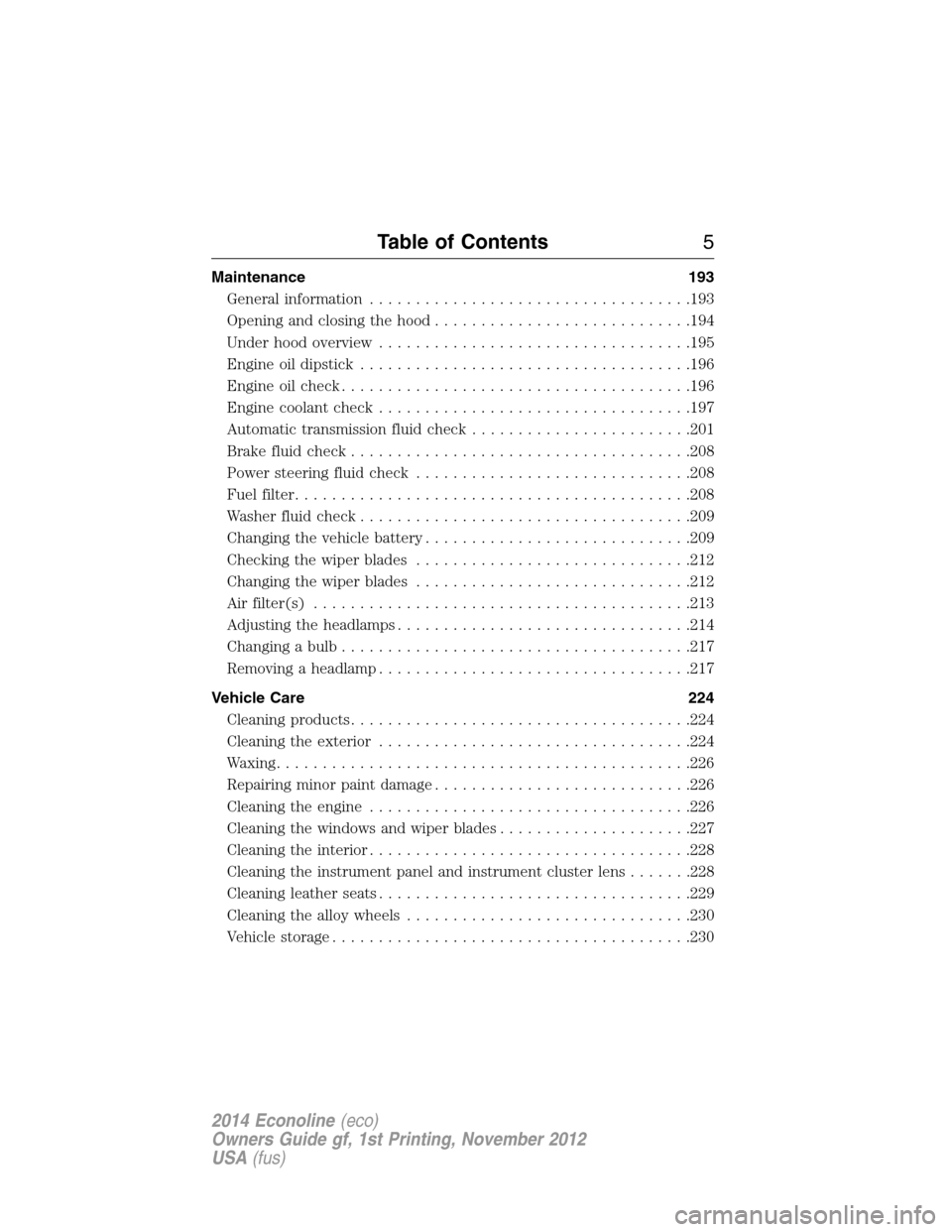
Maintenance 193
General information...................................193
Opening and closing the hood............................194
Under hood overview..................................195
Engine oil dipstick....................................196
Engine oil check......................................196
Engine coolant check..................................197
Automatic transmission fluid check........................201
Brake fluid check.....................................208
Power steering fluid check..............................208
Fuel filter...........................................208
Washer fluid check....................................209
Changing the vehicle battery.............................209
Checking the wiper blades..............................212
Changing the wiper blades..............................212
Air filter(s).........................................213
Adjusting the headlamps................................214
Changing a bulb......................................217
Removing a headlamp..................................217
Vehicle Care 224
Cleaning products.....................................224
Cleaning the exterior..................................224
Waxing.............................................226
Repairing minor paint damage............................226
Cleaning the engine...................................226
Cleaning the windows and wiper blades.....................227
Cleaning the interior...................................228
Cleaning the instrument panel and instrument cluster lens.......228
Cleaning leather seats..................................229
Cleaning the alloy wheels...............................230
Vehiclestorage.......................................230
Table of Contents5
2014 Econoline(eco)
Owners Guide gf, 1st Printing, November 2012
USA(fus)
Page 68 of 438
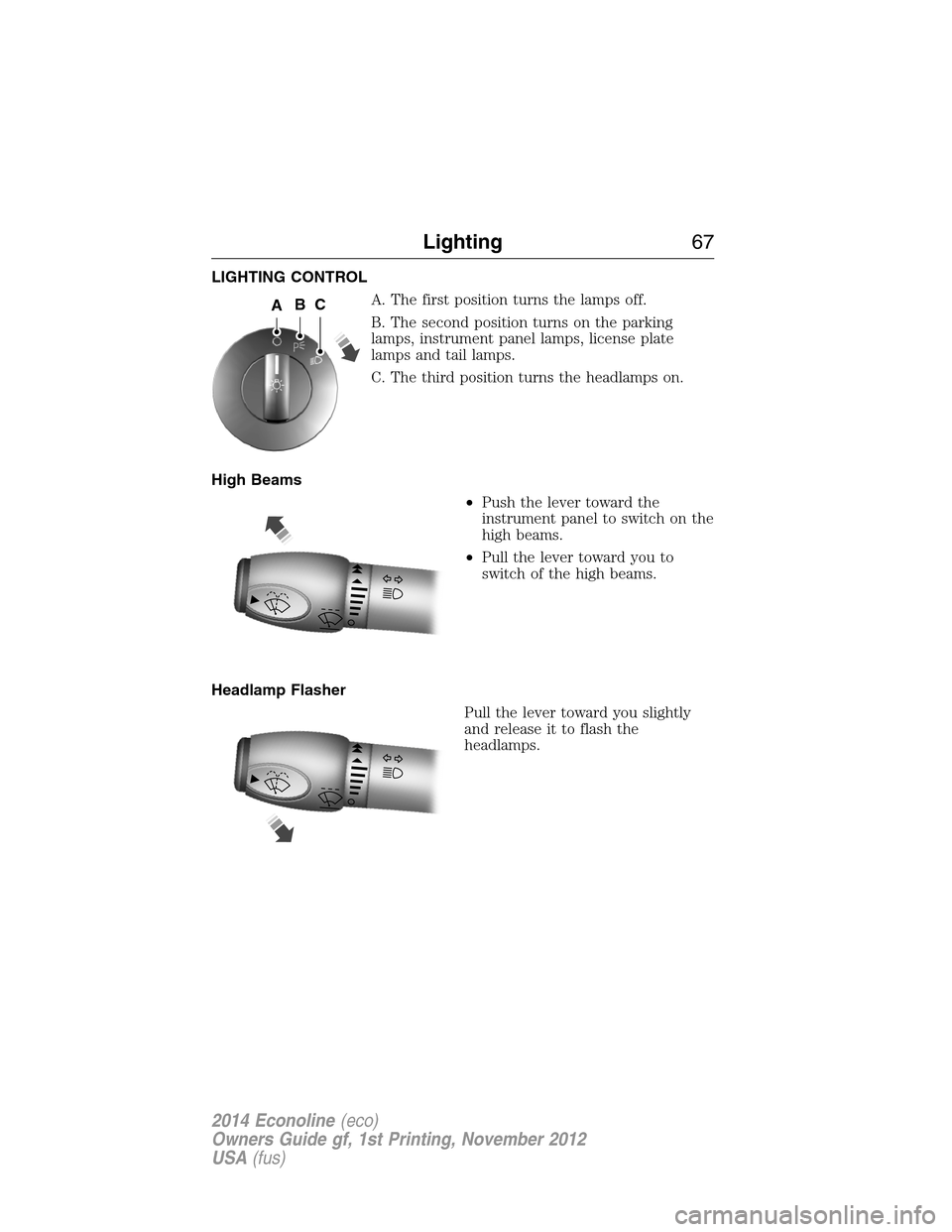
LIGHTING CONTROL
A. The first position turns the lamps off.
B. The second position turns on the parking
lamps, instrument panel lamps, license plate
lamps and tail lamps.
C. The third position turns the headlamps on.
High Beams
•Push the lever toward the
instrument panel to switch on the
high beams.
•Pull the lever toward you to
switch of the high beams.
Headlamp Flasher
Pull the lever toward you slightly
and release it to flash the
headlamps.
ABC
Lighting67
2014 Econoline(eco)
Owners Guide gf, 1st Printing, November 2012
USA(fus)
Page 69 of 438
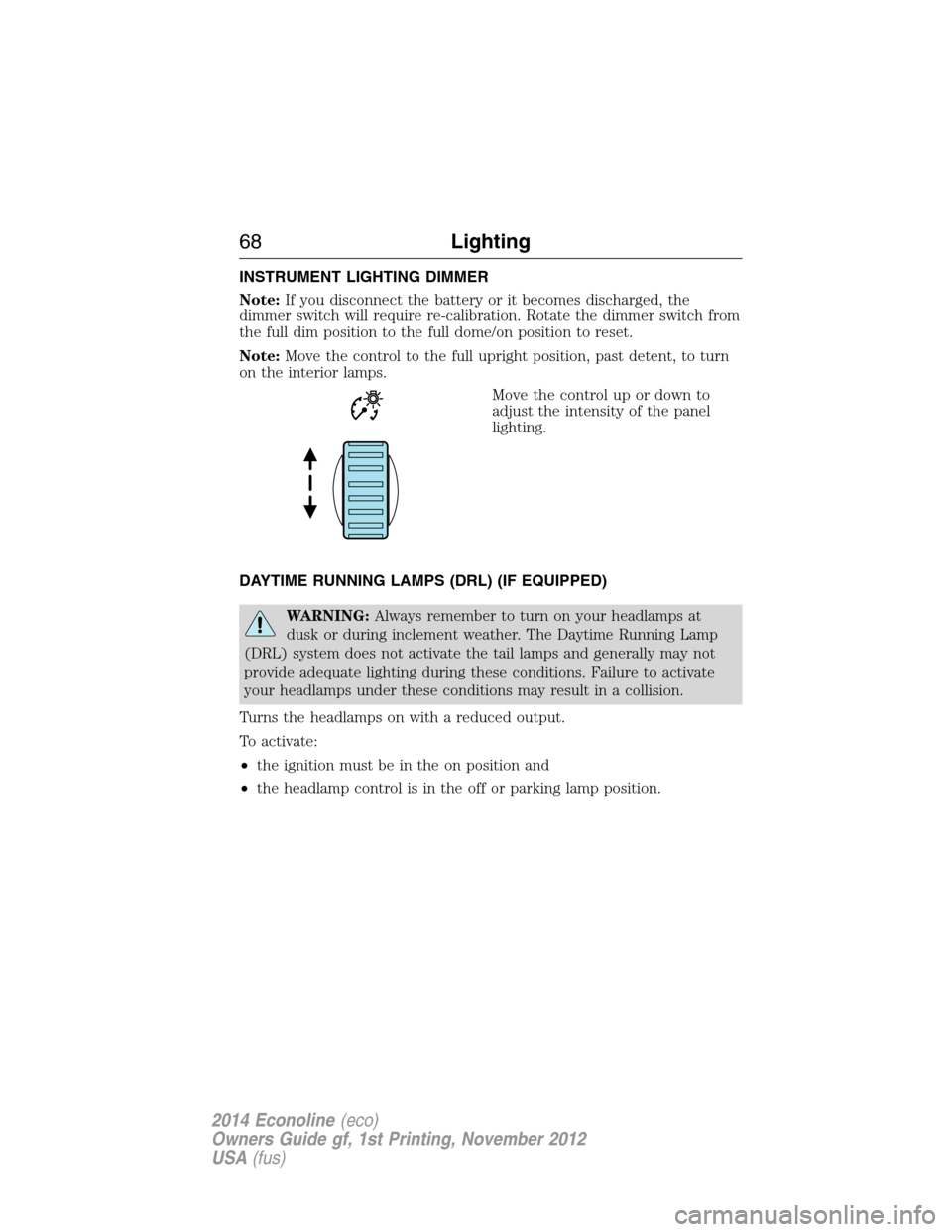
INSTRUMENT LIGHTING DIMMER
Note:If you disconnect the battery or it becomes discharged, the
dimmer switch will require re-calibration. Rotate the dimmer switch from
the full dim position to the full dome/on position to reset.
Note:Move the control to the full upright position, past detent, to turn
on the interior lamps.
Move the control up or down to
adjust the intensity of the panel
lighting.
DAYTIME RUNNING LAMPS (DRL) (IF EQUIPPED)
WARNING:Always remember to turn on your headlamps at
dusk or during inclement weather. The Daytime Running Lamp
(DRL) system does not activate the tail lamps and generally may not
provide adequate lighting during these conditions. Failure to activate
your headlamps under these conditions may result in a collision.
Turns the headlamps on with a reduced output.
To activate:
•the ignition must be in the on position and
•the headlamp control is in the off or parking lamp position.
68Lighting
2014 Econoline(eco)
Owners Guide gf, 1st Printing, November 2012
USA(fus)
Page 91 of 438

HEATER ONLY SYSTEM
A.Fan speed control:Controls the volume of air circulated in your
vehicle. Adjust to select the desired fan speed or switch off. If you
switch the fan off, the windshield may fog up.
B.Temperature control:Controls the temperature of the air circulated
in your vehicle. Adjust to select the desired temperature.
C.Air distribution control:Adjust to select the desired air
distribution.
•VENT:Select to distribute air through the instrument panel air vents.
•FLR:Select to distribute air through the floor vents.
•OFF:Select to turn the system off.
•MIX:Select to distribute air through the instrument panel and floor
air vents.
Select to distribute air through the windshield air vents. You
can also use this setting to defog and clear the windshield of a
thin covering of ice. You can also increase the temperature and
fan speed to improve clearing.
HI
LO
COOL WARMVENTFLROFF
MIX FAN
ABC
90Climate Control
2014 Econoline(eco)
Owners Guide gf, 1st Printing, November 2012
USA(fus)
Page 92 of 438
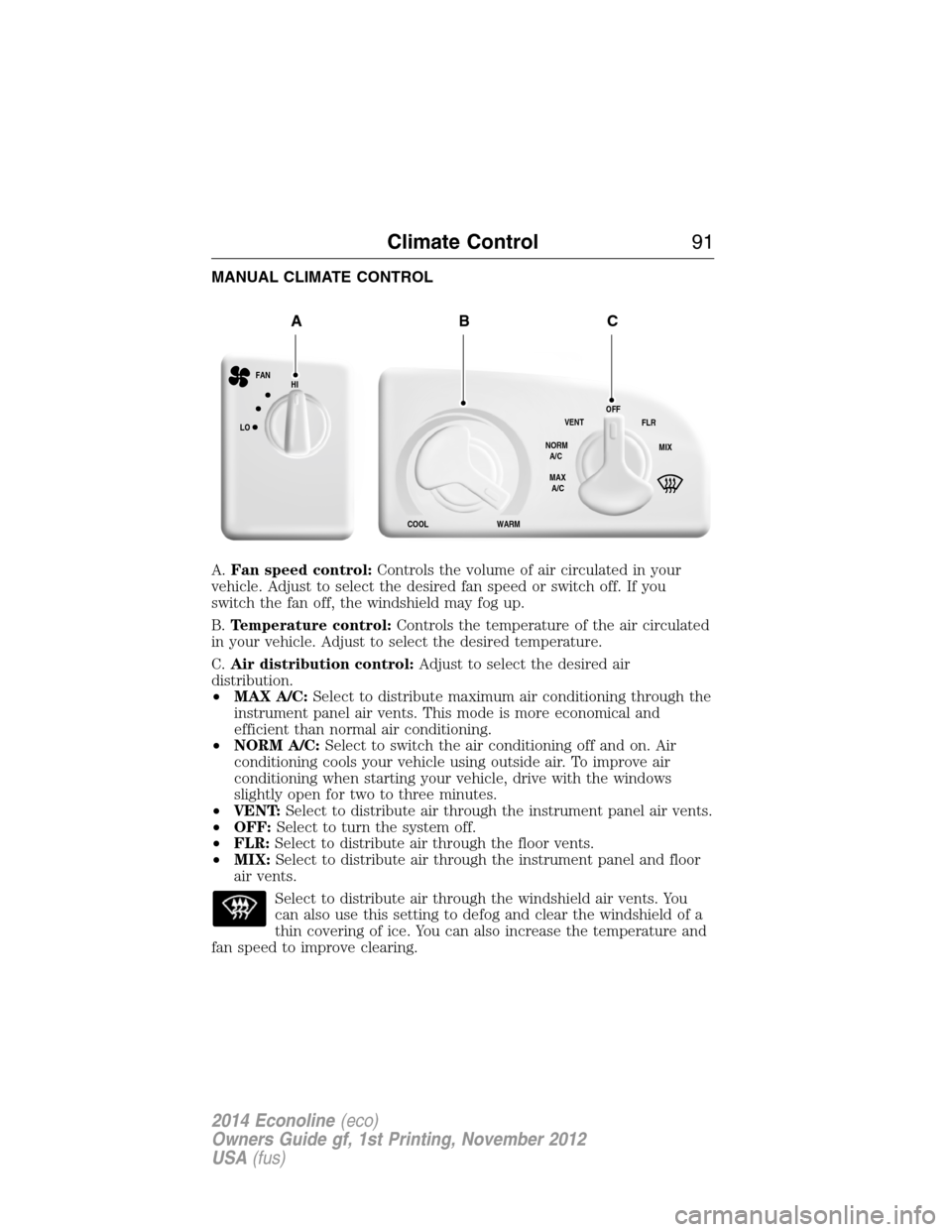
MANUAL CLIMATE CONTROL
A.Fan speed control:Controls the volume of air circulated in your
vehicle. Adjust to select the desired fan speed or switch off. If you
switch the fan off, the windshield may fog up.
B.Temperature control:Controls the temperature of the air circulated
in your vehicle. Adjust to select the desired temperature.
C.Air distribution control:Adjust to select the desired air
distribution.
•MAX A/C:Select to distribute maximum air conditioning through the
instrument panel air vents. This mode is more economical and
efficient than normal air conditioning.
•NORM A/C:Select to switch the air conditioning off and on. Air
conditioning cools your vehicle using outside air. To improve air
conditioning when starting your vehicle, drive with the windows
slightly open for two to three minutes.
•VENT:Select to distribute air through the instrument panel air vents.
•OFF:Select to turn the system off.
•FLR:Select to distribute air through the floor vents.
•MIX:Select to distribute air through the instrument panel and floor
air vents.
Select to distribute air through the windshield air vents. You
can also use this setting to defog and clear the windshield of a
thin covering of ice. You can also increase the temperature and
fan speed to improve clearing.
HI
LO
COOL WARMVENT
NORM
A/C
MAX
A/COFF
MIX FLR FAN
ABC
Climate Control91
2014 Econoline(eco)
Owners Guide gf, 1st Printing, November 2012
USA(fus)
Page 94 of 438
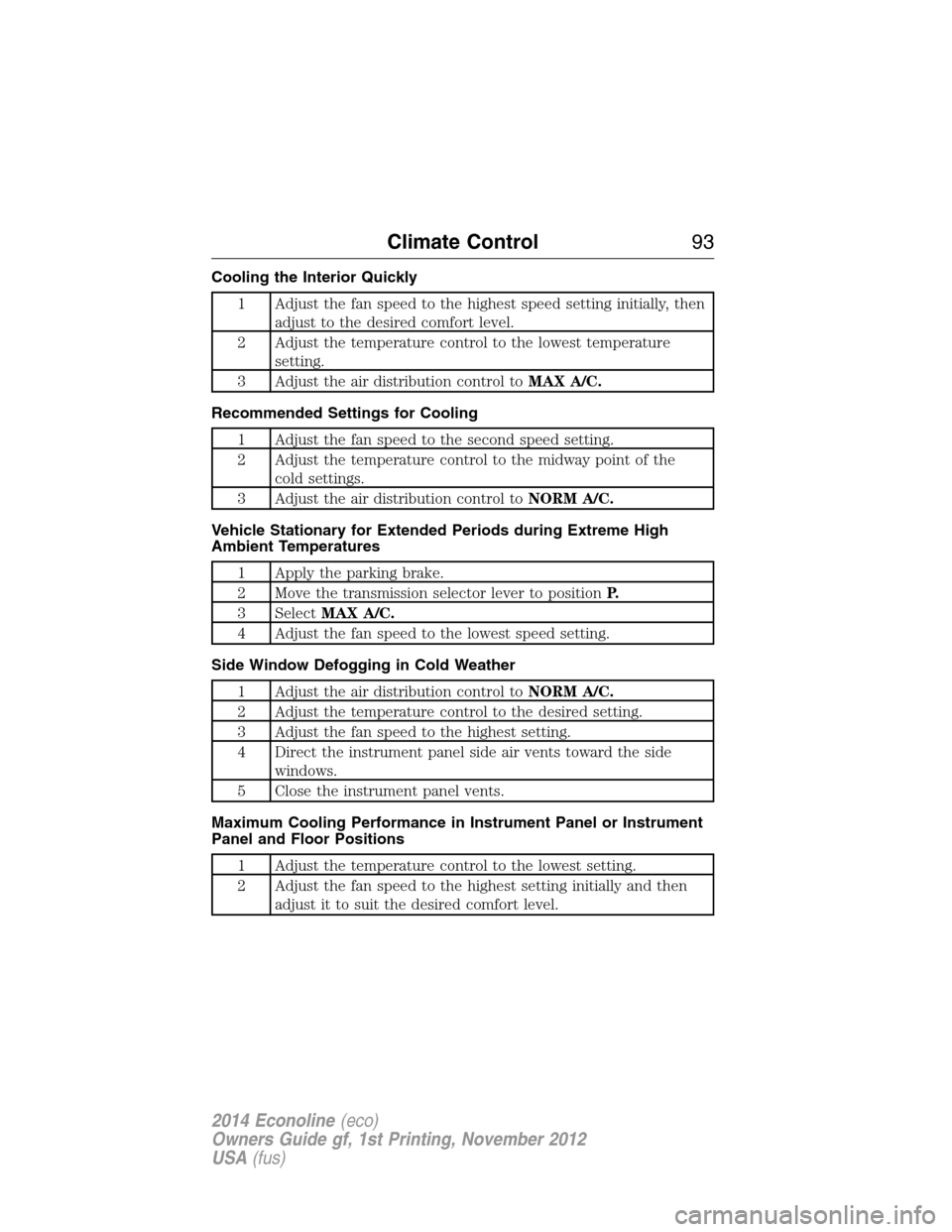
Cooling the Interior Quickly
1 Adjust the fan speed to the highest speed setting initially, then
adjust to the desired comfort level.
2 Adjust the temperature control to the lowest temperature
setting.
3 Adjust the air distribution control toMAX A/C.
Recommended Settings for Cooling
1 Adjust the fan speed to the second speed setting.
2 Adjust the temperature control to the midway point of the
cold settings.
3 Adjust the air distribution control toNORM A/C.
Vehicle Stationary for Extended Periods during Extreme High
Ambient Temperatures
1 Apply the parking brake.
2 Move the transmission selector lever to positionP.
3 SelectMAX A/C.
4 Adjust the fan speed to the lowest speed setting.
Side Window Defogging in Cold Weather
1 Adjust the air distribution control toNORM A/C.
2 Adjust the temperature control to the desired setting.
3 Adjust the fan speed to the highest setting.
4 Direct the instrument panel side air vents toward the side
windows.
5 Close the instrument panel vents.
Maximum Cooling Performance in Instrument Panel or Instrument
Panel and Floor Positions
1 Adjust the temperature control to the lowest setting.
2 Adjust the fan speed to the highest setting initially and then
adjust it to suit the desired comfort level.
Climate Control93
2014 Econoline(eco)
Owners Guide gf, 1st Printing, November 2012
USA(fus)
Page 103 of 438
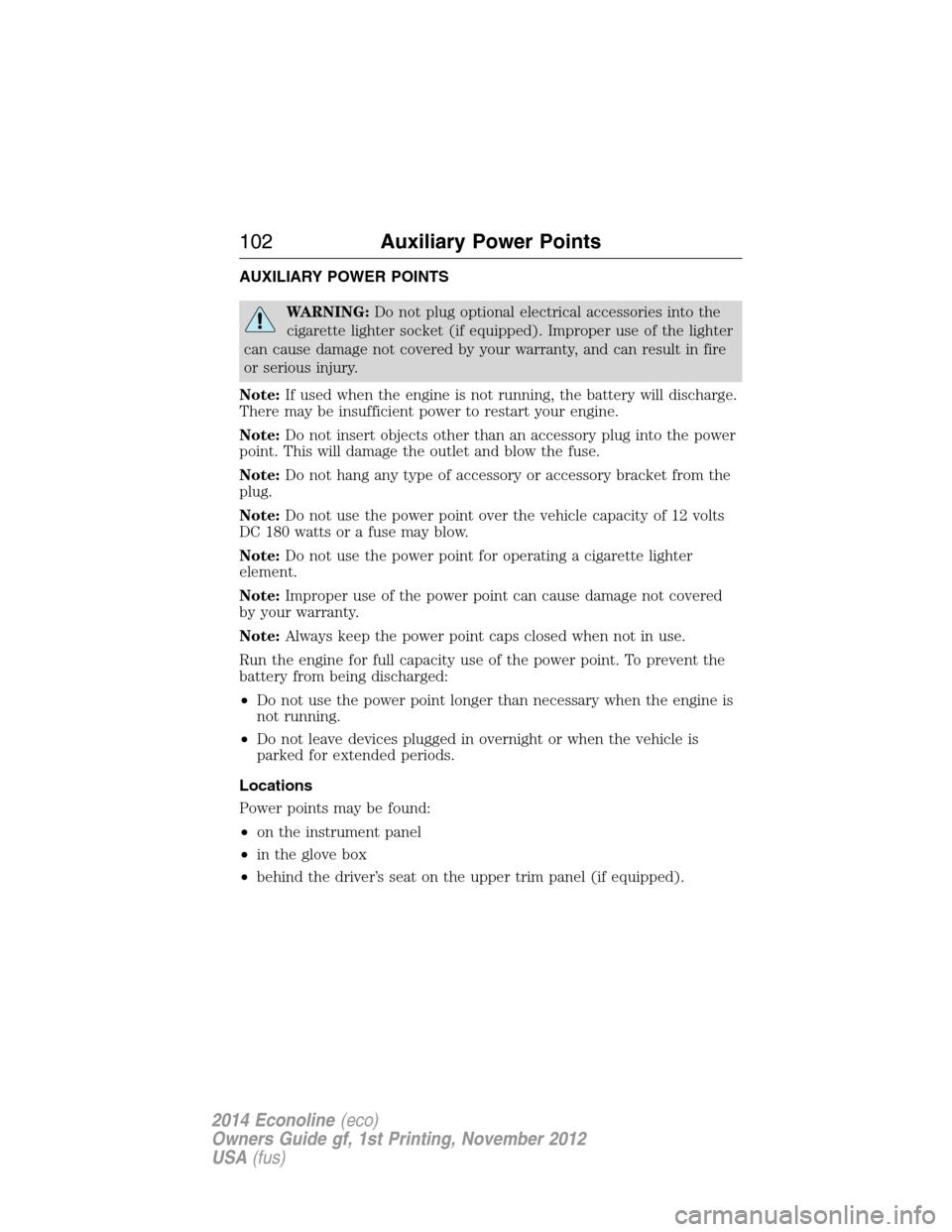
AUXILIARY POWER POINTS
WARNING:Do not plug optional electrical accessories into the
cigarette lighter socket (if equipped). Improper use of the lighter
can cause damage not covered by your warranty, and can result in fire
or serious injury.
Note:If used when the engine is not running, the battery will discharge.
There may be insufficient power to restart your engine.
Note:Do not insert objects other than an accessory plug into the power
point. This will damage the outlet and blow the fuse.
Note:Do not hang any type of accessory or accessory bracket from the
plug.
Note:Do not use the power point over the vehicle capacity of 12 volts
DC 180 watts or a fuse may blow.
Note:Do not use the power point for operating a cigarette lighter
element.
Note:Improper use of the power point can cause damage not covered
by your warranty.
Note:Always keep the power point caps closed when not in use.
Run the engine for full capacity use of the power point. To prevent the
battery from being discharged:
•Do not use the power point longer than necessary when the engine is
not running.
•Do not leave devices plugged in overnight or when the vehicle is
parked for extended periods.
Locations
Power points may be found:
•on the instrument panel
•in the glove box
•behind the driver’s seat on the upper trim panel (if equipped).
102Auxiliary Power Points
2014 Econoline(eco)
Owners Guide gf, 1st Printing, November 2012
USA(fus)
Page 104 of 438
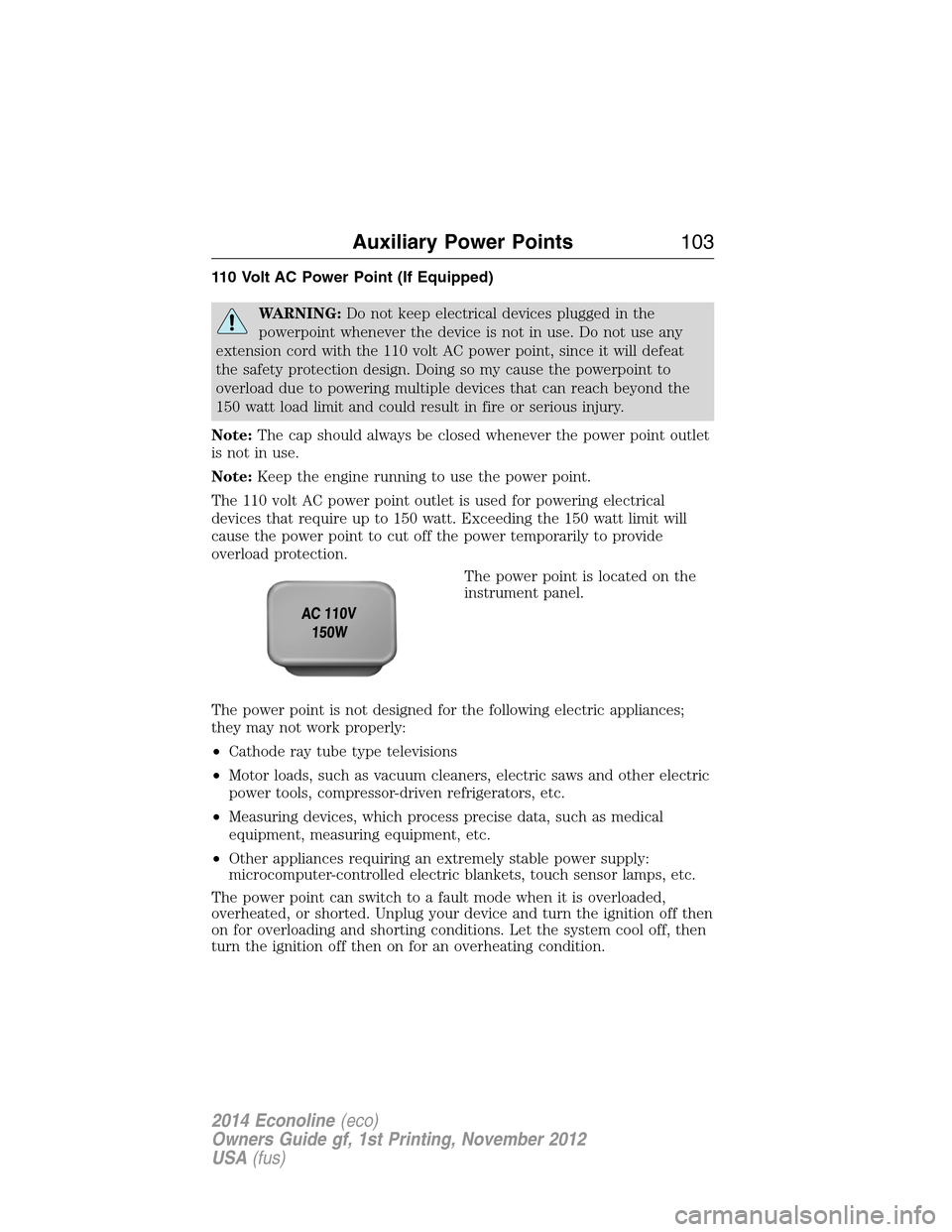
110 Volt AC Power Point (If Equipped)
WARNING:Do not keep electrical devices plugged in the
powerpoint whenever the device is not in use. Do not use any
extension cord with the 110 volt AC power point, since it will defeat
the safety protection design. Doing so my cause the powerpoint to
overload due to powering multiple devices that can reach beyond the
150 watt load limit and could result in fire or serious injury.
Note:The cap should always be closed whenever the power point outlet
is not in use.
Note:Keep the engine running to use the power point.
The 110 volt AC power point outlet is used for powering electrical
devices that require up to 150 watt. Exceeding the 150 watt limit will
cause the power point to cut off the power temporarily to provide
overload protection.
The power point is located on the
instrument panel.
The power point is not designed for the following electric appliances;
they may not work properly:
•Cathode ray tube type televisions
•Motor loads, such as vacuum cleaners, electric saws and other electric
power tools, compressor-driven refrigerators, etc.
•Measuring devices, which process precise data, such as medical
equipment, measuring equipment, etc.
•Other appliances requiring an extremely stable power supply:
microcomputer-controlled electric blankets, touch sensor lamps, etc.
The power point can switch to a fault mode when it is overloaded,
overheated, or shorted. Unplug your device and turn the ignition off then
on for overloading and shorting conditions. Let the system cool off, then
turn the ignition off then on for an overheating condition.
Auxiliary Power Points103
2014 Econoline(eco)
Owners Guide gf, 1st Printing, November 2012
USA(fus)
Page 130 of 438
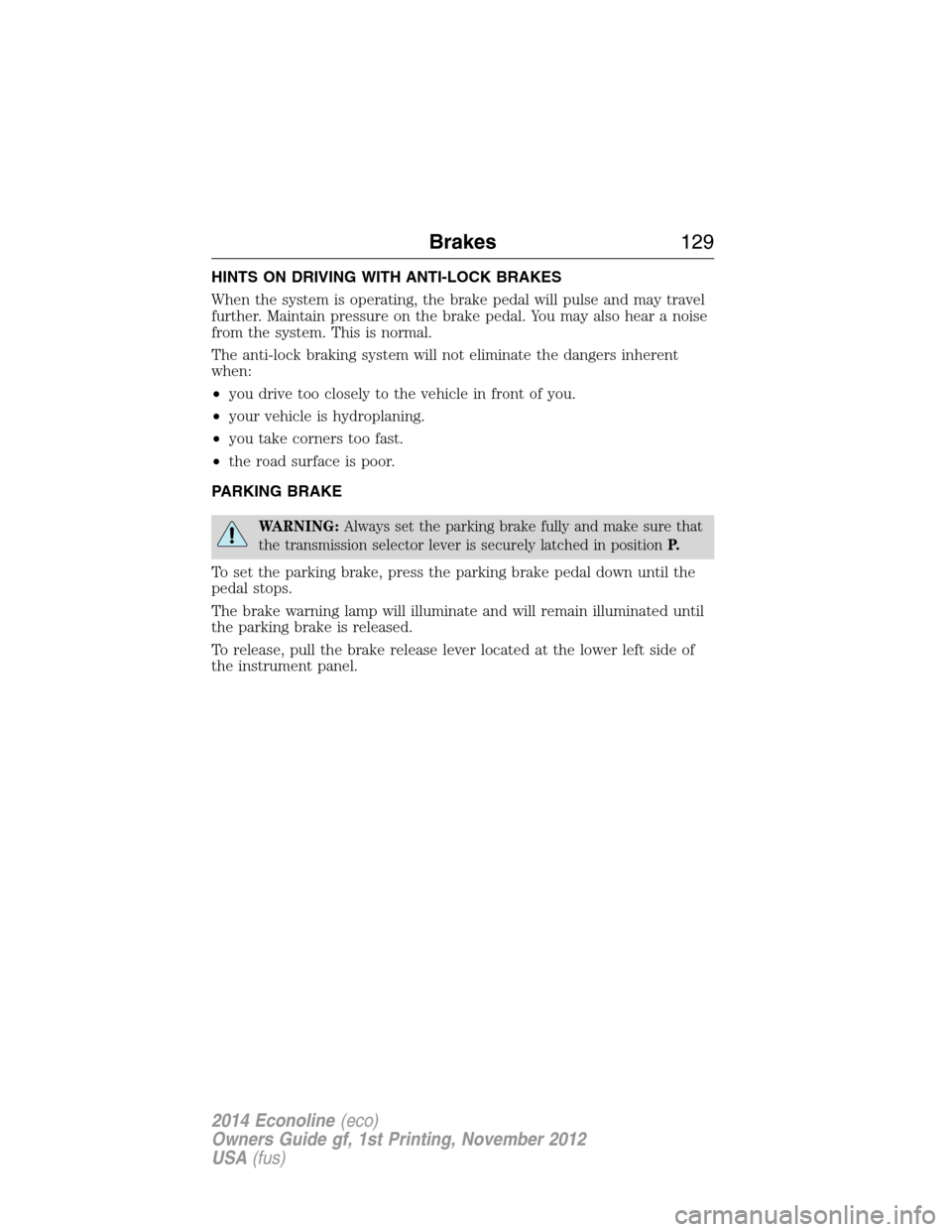
HINTS ON DRIVING WITH ANTI-LOCK BRAKES
When the system is operating, the brake pedal will pulse and may travel
further. Maintain pressure on the brake pedal. You may also hear a noise
from the system. This is normal.
The anti-lock braking system will not eliminate the dangers inherent
when:
•you drive too closely to the vehicle in front of you.
•your vehicle is hydroplaning.
•you take corners too fast.
•the road surface is poor.
PARKING BRAKE
WARNING:Always set the parking brake fully and make sure that
the transmission selector lever is securely latched in positionP.
To set the parking brake, press the parking brake pedal down until the
pedal stops.
The brake warning lamp will illuminate and will remain illuminated until
the parking brake is released.
To release, pull the brake release lever located at the lower left side of
the instrument panel.
Brakes129
2014 Econoline(eco)
Owners Guide gf, 1st Printing, November 2012
USA(fus)
Page 131 of 438
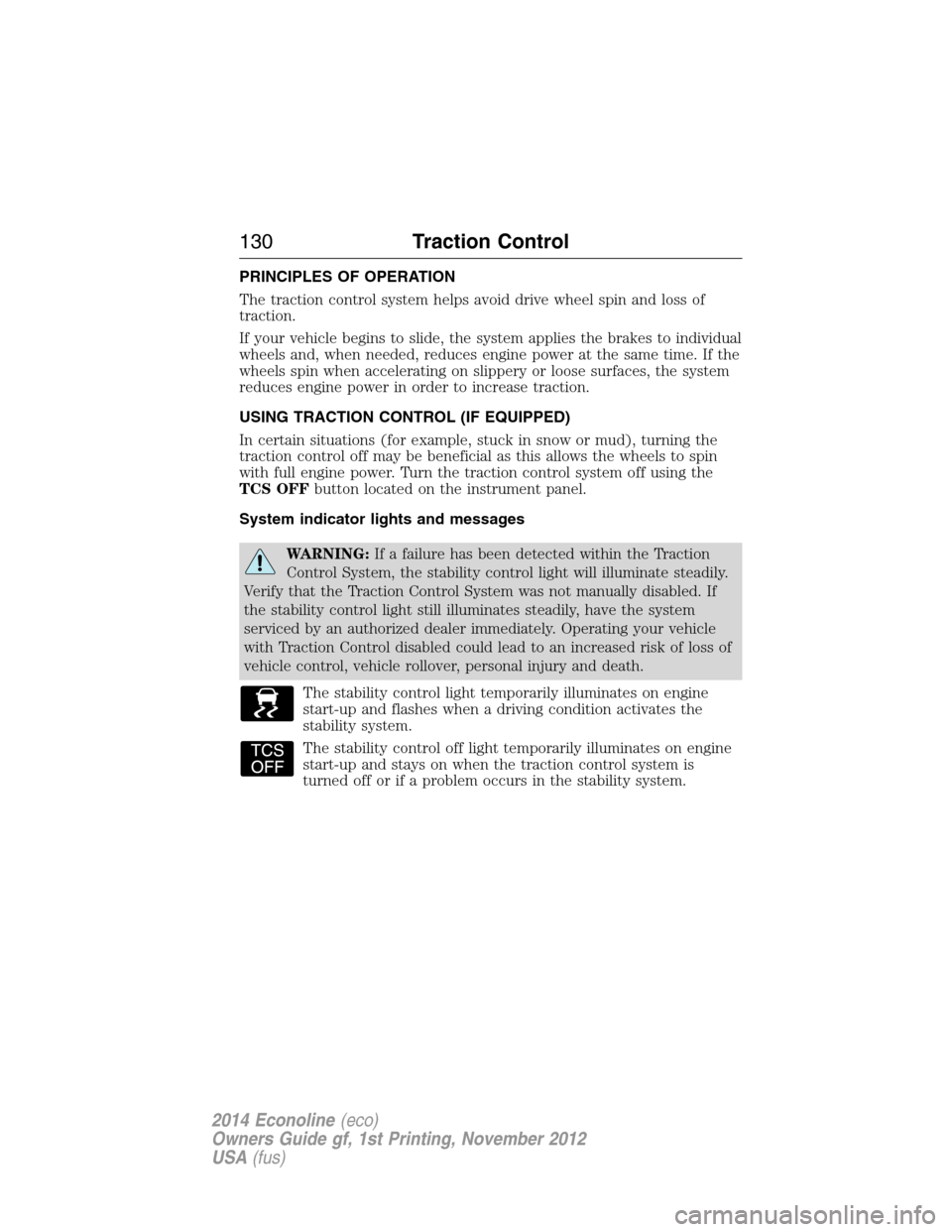
PRINCIPLES OF OPERATION
The traction control system helps avoid drive wheel spin and loss of
traction.
If your vehicle begins to slide, the system applies the brakes to individual
wheels and, when needed, reduces engine power at the same time. If the
wheels spin when accelerating on slippery or loose surfaces, the system
reduces engine power in order to increase traction.
USING TRACTION CONTROL (IF EQUIPPED)
In certain situations (for example, stuck in snow or mud), turning the
traction control off may be beneficial as this allows the wheels to spin
with full engine power. Turn the traction control system off using the
TCS OFFbutton located on the instrument panel.
System indicator lights and messages
WARNING:If a failure has been detected within the Traction
Control System, the stability control light will illuminate steadily.
Verify that the Traction Control System was not manually disabled. If
the stability control light still illuminates steadily, have the system
serviced by an authorized dealer immediately. Operating your vehicle
with Traction Control disabled could lead to an increased risk of loss of
vehicle control, vehicle rollover, personal injury and death.
The stability control light temporarily illuminates on engine
start-up and flashes when a driving condition activates the
stability system.
The stability control off light temporarily illuminates on engine
start-up and stays on when the traction control system is
turned off or if a problem occurs in the stability system.
130Traction Control
2014 Econoline(eco)
Owners Guide gf, 1st Printing, November 2012
USA(fus)